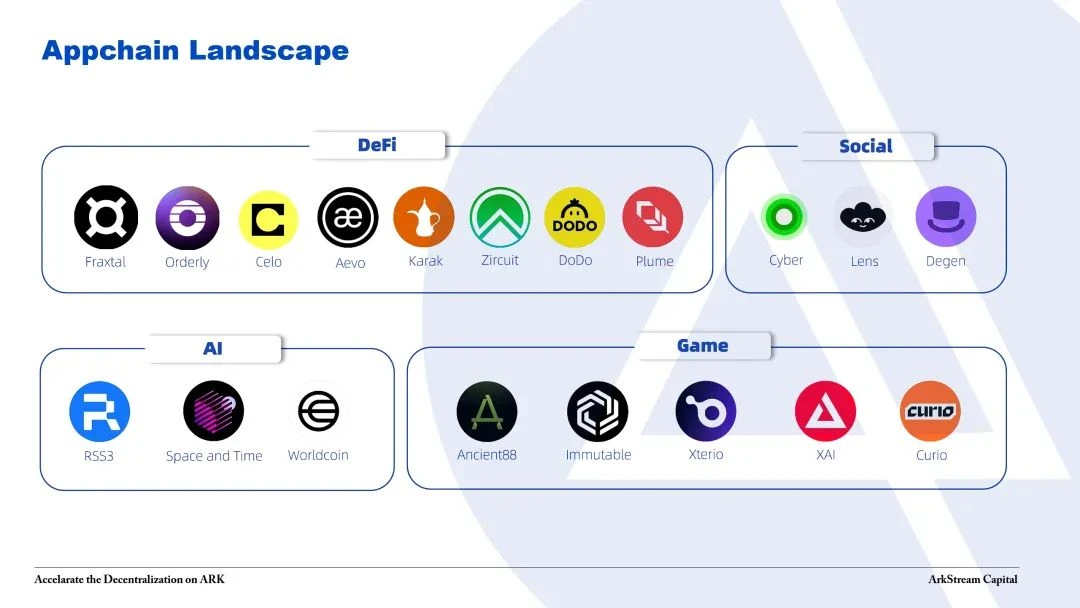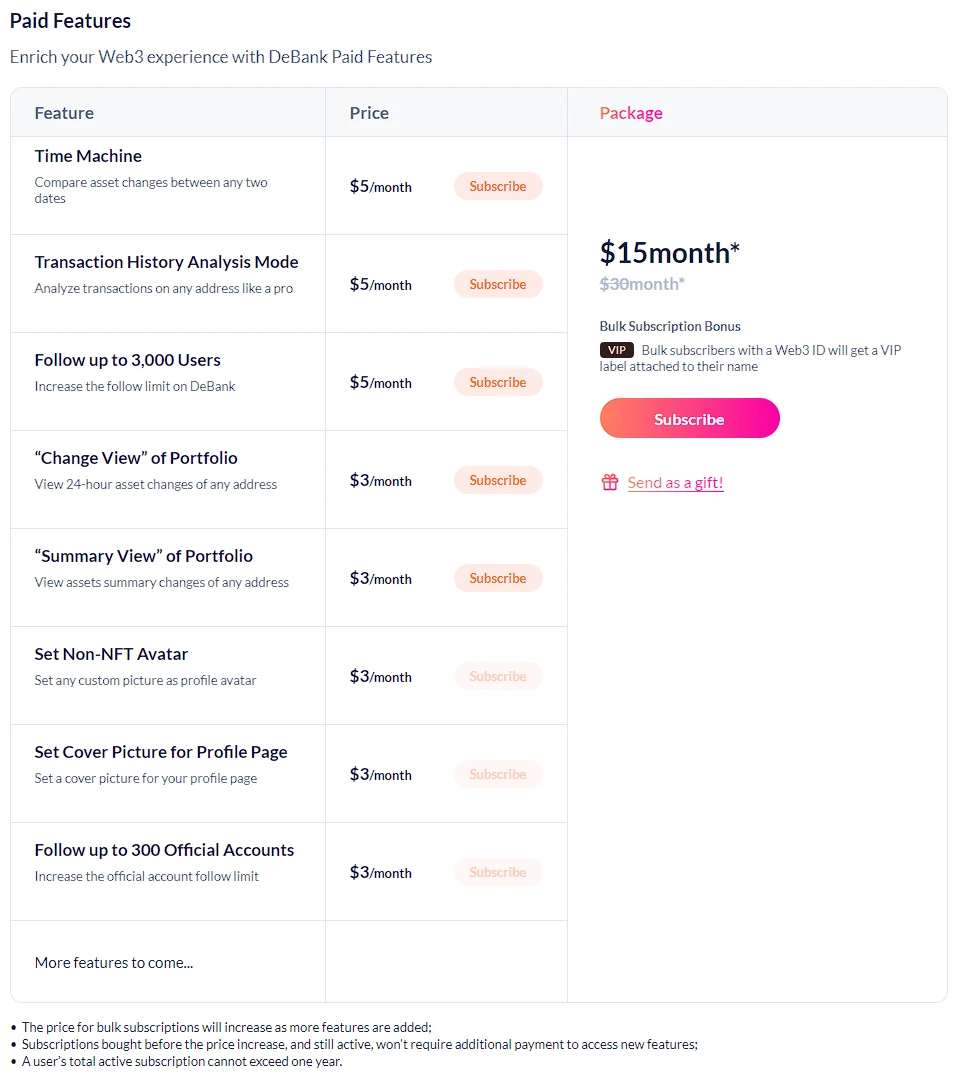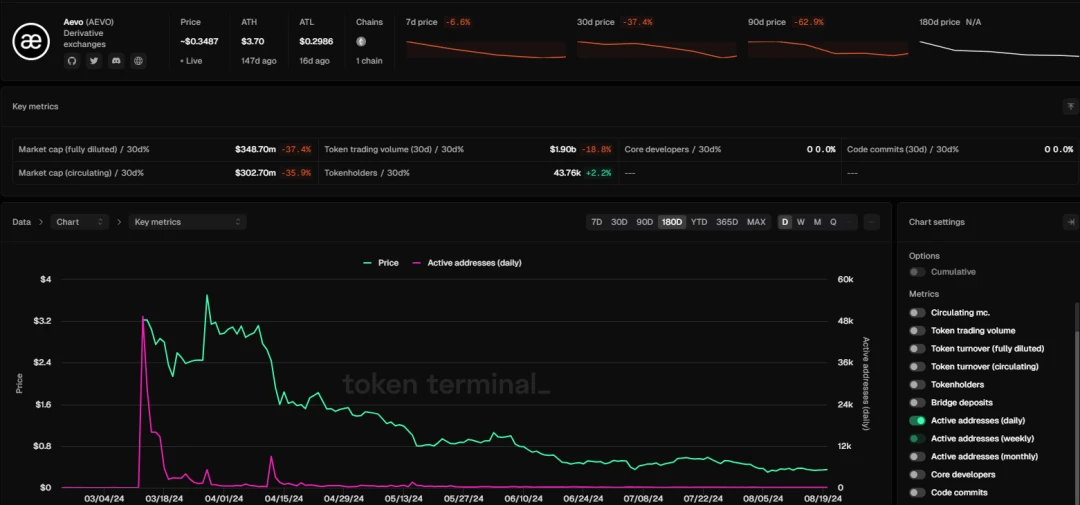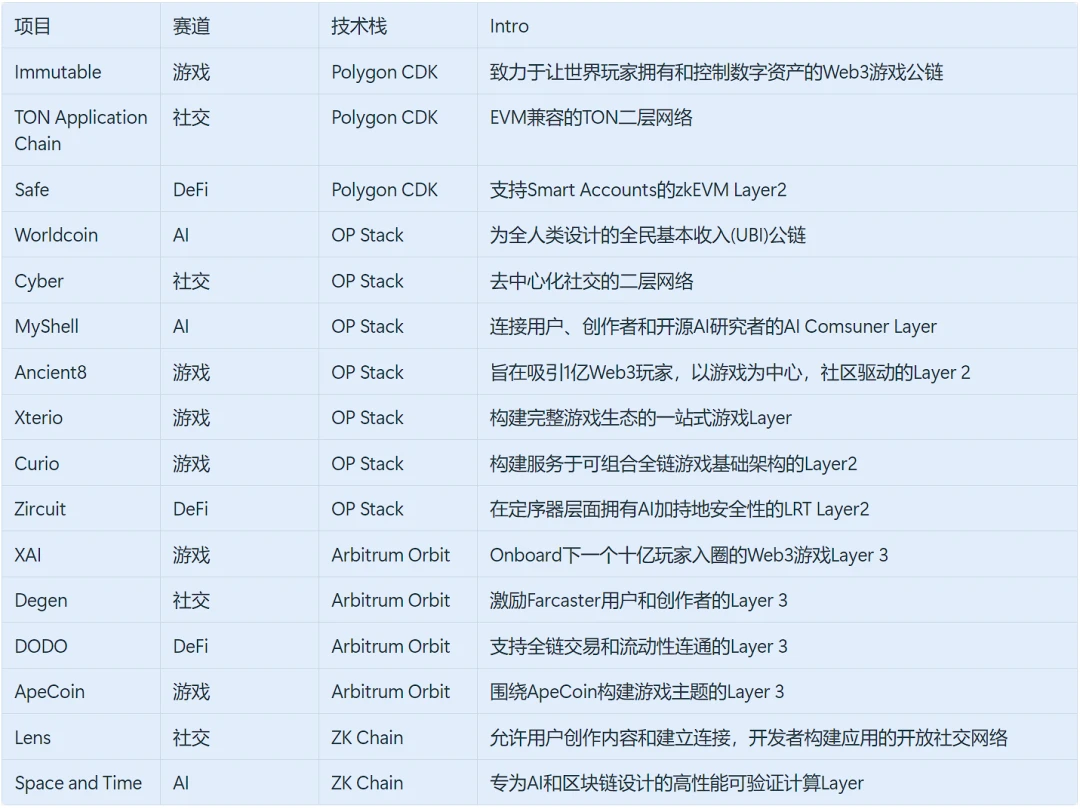요약
1. 애플리케이션 체인의 개발은 인프라의 성숙도, 블록 공간에 대한 경쟁 심화, 맞춤형 토큰 경제 모델에 대한 수요 증가를 포함한 여러 요소의 결합 효과의 결과입니다.
2. dApp과 애플리케이션 체인은 비즈니스 형태가 유사하지만 각각 장단점이 있습니다. 생태계와의 시너지를 강조하는 경우 dApp이 더 적합할 수 있지만 자율성과 독립성을 추구하는 경우 애플리케이션 체인이 더 나은 선택입니다.
3. 코스모스와 폴카닷의 개발은 기술적 어려움과 더불어 경제적 메커니즘 설계와 애플리케이션 체인의 높은 한계로 인해 제한적입니다.
4. 애플리케이션 체인 개발의 핵심은 자체 애플리케이션 장벽을 구축하고 저비용 거래를 최대한 활용하여 고빈도 온체인 거래를 촉진한 다음 트래픽을 확보하고 사용자를 축적하는 것입니다. 기술 지원과 개선이 중요하지만 핵심 요소가 아닌 보조적인 요소일 뿐입니다.
5. 미래의 애플리케이션 체인은 집계 계층, 슈퍼 체인 또는 체인 추상화와 같은 기술을 통해 기존의 유동성 단편화 및 상호 운용성 문제를 해결할 수 있을 것입니다.
6. 애플리케이션 체인의 시장 가치 또는 완전 희석된 평가는 어느 정도 보너스를 받았지만, 실제 핵심은 애플리케이션 자체의 제품 품질과 사용자 경험입니다.
애플리케이션 체인의 불가피한 개발 추세
2023년과 2024년에 점점 더 많은 dApp이 애플리케이션 체인으로의 전환을 발표했습니다. 이러한 현상에 대응하여 전체 애플리케이션 체인 트랙을 계산한 결과 이러한 애플리케이션 체인은 주로 DeFi, 게임, 소셜 네트워킹 및 AI에 집중되어 있음을 발견했습니다. 모듈식 기술의 성숙, 일반 Rollup 2계층 네트워크의 광범위한 검증, RaaS 플랫폼의 증가 및 서비스 개선, dApp의 퍼블릭 체인 블록 공간 리소스에 대한 경쟁, 최종 사용자 거래 비용의 최적화, 토큰 경제의 맞춤형 요구 사항으로 인해 애플리케이션 체인의 개발이 불가피한 추세가 되었다고 생각합니다.
이러한 추세에 대해, 우리는 dApp을 애플리케이션 체인으로 업그레이드하는 것이 즉시 높은 가치의 인프라 계층으로 전환되지 않을 것이라고 생각합니다. 왜냐하면 dApp과 애플리케이션 체인은 성공을 위한 결정적 요인이라기보다는 기술 선택에 가깝기 때문입니다. 애플리케이션 체인의 장점은 저비용 거래를 통해 더 높은 빈도의 온체인 거래를 촉진하고, 데이터 축적을 사용하여 사용자 제품 경험을 개선하고, 사용자 끈적임을 형성하여 네트워크 효과를 달성한다는 것입니다. 따라서 애플리케이션 체인 개발의 핵심은 여전히 고유한 애플리케이션 장벽과 트래픽에 있습니다.
애플리케이션 체인의 원점 탐색
애플리케이션 체인의 기원에 대해 이야기할 때, 우리는 선구적인 프로젝트인 코스모스를 언급해야 합니다. 코스모스는 모듈식 및 플러그형 설계 개념으로 유명합니다. 이는 가상 머신과 합의 엔진을 분리하여 개발자가 가상 머신을 빌드하기 위한 프레임워크를 자유롭게 선택하고 검증자 수와 TPS와 같은 합의 엔진의 주요 매개변수를 사용자 정의할 수 있도록 합니다. 이 설계를 통해 다양한 애플리케이션이 독립적인 체인으로 존재하고 유연성과 주권에서 고유한 이점을 보여줄 수 있습니다. 이러한 혁신적인 개념 덕분에 코스모스는 애플리케이션 체인의 탐색 및 실행에 중요한 기여를 할 수 있었고, 이 분야의 견고한 기반을 마련했습니다.
Mintscan에서 Cosmos 애플리케이션 체인 생태계의 개발을 살펴보면, dYdX, Osmosis, Fetch AI, Band, Stride와 같이 잘 알려지고 성숙한 애플리케이션 체인이 많이 Cosmos 프레임워크에 구축되어 있음을 발견했습니다. 그러나 전체 Cosmos 애플리케이션 체인의 성장 추세는 지속되지 않았고, 새로운 애플리케이션 체인의 수도 크게 증가하지 않았습니다. 이는 주로 Cosmos가 애플리케이션 체인에 너무 많은 주권을 부여했기 때문이라고 생각하며, Atom 2.0 ICS 솔루션이 출시되기 전에는 애플리케이션 체인의 보안과 높은 시작 및 유지 관리 비용이 주된 이유였습니다.
일반적으로 Cosmos 애플리케이션 체인을 구축하려면 프로젝트 당사자가 Cosmos SDK와 Tendermint 합의 엔진에 익숙한 개발 팀을 갖춰야 하며, 이는 애플리케이션 개발에 집중하는 기술 팀에 추가적인 기술적 부담이 됩니다. 또한 Cosmos 애플리케이션 체인이 충분한 기술 인력을 갖출 수 있다 하더라도 대부분 애플리케이션 체인의 시작 논리는 초기 검증자가 참여하도록 유도하고 Cosmos 검증자에게 토큰을 에어드랍하여 네트워크 보안을 보장하는 동시에 검증자에게 높은 인플레이션율을 통해 네트워크 보안을 지속적으로 유지하도록 인센티브를 제공하는 것입니다. 그러나 이러한 관행의 부작용은 토큰의 가치 하락을 가속화하여 네트워크 가치가 급격히 하락한다는 것입니다. 이러한 상황으로 인해 애플리케이션 체인이 시장에서 발판을 마련하기가 더 어려워집니다.
Atom 2.0에서 옹호하는 ICS 계획에 따라 애플리케이션 체인의 개념은 허가 없는 소비자 체인 모델로 업그레이드되지만 허가 없는 소비자 체인 가입을 허용하여 소비자 체인이 보안을 얻는 데 드는 비용을 줄입니다. 그러나 이러한 형태의 DAO 기반 투표 거버넌스는 동시에 출시된 Polkadot 슬롯 경매 메커니즘과 유사하며 슬롯 경매 메커니즘의 비효율적인 개발 문제에 직면할 수 있습니다.
또한, 우리는 코스모스가 체인의 활성 특성, 개발자 문서 리소스, 커뮤니티 문화 측면에서 애플리케이션 체인에 충분히 매력적이지 않다는 것을 발견했습니다. 예를 들어, 올해 코스모스 허브의 블록 생산 중단 사건, 2023년 말 등록 피크 기간 동안의 불완전한 개발 문서 리소스, 델파이 공동 창립자 요세 마리아 마세도가 지적한 인터체인 재단의 소규모 서클 문제는 모두 새로운 애플리케이션 체인의 가입에 부정적인 영향을 미쳤습니다.
새로운 애플리케이션 체인을 위한 촉매
코스모스의 초기 애플리케이션 체인을 체인 중심 애플리케이션으로 간주하여 체인의 주권적 설계를 강조한다면, 새로운 애플리케이션 체인은 더 애플리케이션 중심적이며 자체 애플리케이션 개발에 집중합니다. 이 새로운 애플리케이션 체인의 부상은 주로 모듈형 블록체인 개념의 대중화, 일반 Rollup Layer 2의 성숙 및 광범위한 검증, 상호 운용성 및 유동성 집계 계층의 개발, RaaS 플랫폼의 부상 및 개선 때문입니다.
메인넷에서 라이브로 전환되는 최초의 Rollup Layer 2인 Optimism의 2022년 성공적인 출시는 모듈형 블록체인 이론의 실제 구현을 나타냅니다. Optimism은 Ethereum의 보안을 계승할 뿐만 아니라 Ethereum 생태계의 개발 기술 스택을 완벽하게 지원합니다. Optimism은 Rollup이 Ethereum을 효율적으로 확장할 수 있는 방법을 업계에 보여주었고 동시에 업계의 Layer 2 솔루션에 대한 심층적인 탐구를 촉진했습니다. Optimism은 자체 개발을 기반으로 Cosmos의 개념과 프레임워크를 활용하여 OP Stack의 개념을 혁신적으로 제안합니다. 이 개념은 Worldcoin 및 Base와 같은 잘 알려진 프로젝트에서 널리 사용되어 업계에서 광범위한 관심을 끌었습니다. 이후 다른 Rollup 솔루션도 Arbitrum Orbits, Polygon CDK, StarkWare Appchain 및 zkSync Hyperchains와 같은 유사한 개념을 출시했습니다. 이런 방식으로 dApp의 경우 애플리케이션 체인은 비즈니스 로직을 구현하는 새로운 방법이 되었고, 원래 dApp의 업그레이드 및 구현은 더 이상 문제가 되지 않습니다. 주요 과제는 기술 선택, 비즈니스 설계, 운영 및 유지 관리로 옮겨갔습니다.
Rollup 솔루션을 구현할 때는 일반적으로 OP Stack이나 Arbitrum Orbits와 같은 적합한 실행 계층 프레임워크를 선택해야 합니다. OP Stack을 예로 들면, 이는 Ethereum 업데이트(예: Cancuns Blob 기능)로 업그레이드해야 하는 진화하는 Rollup 프레임워크이며, 새로운 기능(예: Alternative Data Availability)도 지원합니다. 이해하기 쉽게 하기 위해 애플리케이션 체인의 개발 프로세스를 단순화하고 대략 다음 단계를 따릅니다.
1. 기술 선택: 다양한 프레임워크의 기능과 특징을 평가하고 가장 적합한 프레임워크를 선택합니다.
2. 수요 설계: 해당 프레임워크의 사용자 정의 기능을 기반으로 요구 사항을 충족하는 애플리케이션 체인을 설계합니다.
3. 운영 및 유지관리: 완전한 배치, 테스트, 출시 및 이후 유지관리.
Rollup 프레임워크는 애플리케이션에 강력한 확장성을 제공하지만, 특히 애플리케이션 체인이 출시된 후에는 적절한 프레임워크를 선택하고 구현하기 쉽지 않습니다. 따라서 Altlayer, Caldera, Conduit과 같은 RaaS(Rollup As A Service) 플랫폼의 등장이 특히 중요합니다. 이러한 플랫폼은 SaaS와 유사하지만 Rollup 솔루션에 중점을 두고 있어 dApp이 다양한 Rollup 프레임워크를 신속하게 선택하고 애플리케이션 체인 개발 프로세스의 복잡한 단계를 간소화하고 사용자 정의 핵심 기능을 제공하며 출시 후 애플리케이션의 유지 관리 및 최적화를 지원할 수 있습니다.
동시에 애플리케이션 체인 주변의 인프라와 관련 기능도 빠르게 발전하고 있으며, 업계는 매력적인 프로토콜과 기능을 계속 출시하고 있습니다. 예를 들어, Celestia, EigenDA, NearDA와 같은 프로젝트는 비용을 절감하고 처리량을 늘리기 위해 Alternative Data Availability를 도입했으며, RaaS 플랫폼은 사용자 정의 Gas 토큰 및 기본 계정 추상화와 같은 기능에 대한 통합 지원을 차례로 출시했습니다. Rollup 애플리케이션 체인이 널리 적용됨에 따라 유동성 단편화 및 상호 운용성 문제가 점차 나타나 Optimisms Superchain, Polygons AggLayer, Calderas Metalayer, zkSyncs Elastic Chain과 같은 집계 및 통합 계층 솔루션이 등장하여 애플리케이션 체인 간의 상호 운용성과 유동성 집계를 개선하는 것을 목표로 합니다.
위의 촉매가 애플리케이션 체인에 가입하기 위한 임계값을 낮추면 1차 및 2차 시장에서의 현재 애플리케이션 딜레마는 dApp이 탈출구를 모색하는 것을 심화시키고 있습니다.CMC와 Rootdata의 데이터를 통해 2차 시장의 상위 100개 프로젝트 중 커뮤니티 중심 및 문화적으로 지원되는 Meme 범주를 제외하고 Uniswap, LDO, Aave, Ondo, Jupiter, Ethena와 같은 순수 애플리케이션 프로젝트가 몇 개뿐이며, 그 외 대부분은 인프라에 속합니다.이는 인프라가 전체 Crypto 산업에서 애플리케이션보다 더 높은 지위를 가지고 있음을 사실상 확인시켜 줍니다.1차 시장에 상응하여 애플리케이션에 대한 자금 조달 금액도 인프라에 대한 자금 조달 금액보다 훨씬 낮습니다.이러한 현상은 부분적으로 Web3 애플리케이션의 UI/UX가 Web2보다 비교적 복잡하고 성숙도와 사용 용이성이 훨씬 낮으며, 동시에 관련 애플리케이션 패러다임 혁신이 실제로 돌파되지 않았기 때문이라고 생각합니다. 그럼에도 불구하고, 우리는 애플리케이션 체인의 잠재력이 아직 완전히 공개되지 않았으며, 앞으로 Web3 개발을 촉진하는 데 중요한 돌파구가 될 수 있다고 믿습니다. 현재 IMX, Cyberconnect, Project Galaxy, Worldcoin 등과 같은 잘 알려진 애플리케이션 체인 프로젝트가 있으며, 애플리케이션 체인의 엄청난 잠재력을 보여주고 있습니다.
새로운 애플리케이션 체인의 장단점
기술과 혁신 분야에서, 실버 총알은 종종 모든 문제를 해결할 수 있는 완벽한 솔루션을 설명하는 데 사용됩니다. 그러나 실제로는 모든 문제를 하룻밤 사이에 해결할 수 있는 기술은 거의 없습니다. 마찬가지로, 새로운 애플리케이션 체인은 보편적이고 완벽한 솔루션이 아닙니다. 아래에서 장단점을 분석합니다.
장점
모듈식 디자인: 애플리케이션 체인은 일반적으로 모듈식 설계를 채택하여 개발자가 결제 메커니즘 및 데이터 가용성과 같은 인프라 구성 요소를 특정 요구 사항에 맞게 사용자 정의할 수 있도록 합니다.
성능 최적화: 많은 새로운 애플리케이션 체인은 다른 데이터 가용성 계층 솔루션을 도입함으로써 비용을 절감하고 처리량을 향상시킬 수 있습니다.
강화된 가치 포착: 사용자 정의 가스 토큰, 계정 추상화 등과 같은 이러한 기능은 보다 유연한 애플리케이션 개발과 보다 복잡한 비즈니스 모델 및 토큰 모델을 지원할 수 있습니다.
단점
유동성 분산: 새로운 애플리케이션 체인은 유동성 분산이라는 문제에 직면할 수 있습니다.
상호 운용성 및 구성성 문제: 애플리케이션 체인은 더 이상 과거 퍼블릭 체인의 dApp처럼 쉽게 결합되고 상호 운용될 수 없습니다.
복잡성 증가: 기존 dApp에 비해 새로운 애플리케이션 체인은 복잡성이 증가했습니다. 특히 설계 및 구현 측면에서 복잡성이 증가했으며, 더 많은 기술적 리소스와 지원이 필요할 수 있습니다.
애플리케이션 체인을 결정하기 위한 핵심 고려 사항
프로젝트 소유자의 관점에서 애플리케이션 체인을 업그레이드할지 선택할지 결정할 때 다음 원칙을 따르는 것이 좋습니다.
1. 기존 퍼블릭 체인의 특성에 대한 의존성: 귀하의 애플리케이션이 유동성이나 제품 기능 등 퍼블릭 체인의 다른 dApp에 크게 의존하는 경우 기존 dApp 솔루션을 계속 사용하는 것이 좋습니다.
2. 사용자 정의 기능이 필요합니다: 현재 애플리케이션이 프로토콜 수준에서 계정 추상화, 특정 온보딩 메커니즘(수익 공유)과 같은 비즈니스 요구 사항을 지원할 수 없고, 이러한 기능이 비즈니스 개발에 중요한 경우 애플리케이션 체인을 선택하거나 마이그레이션하는 것이 좋습니다.
3. 비용 민감성: 최종 사용자가 블록 공간 리소스에 민감하거나 MEV와 같은 손실을 줄이고자 하는 경우 애플리케이션 체인이 더 나은 선택일 수 있습니다. 또한 애플리케이션이 고주파 상호작용 시나리오에 속하는 경우 애플리케이션 체인은 더 높은 리소스 효율성과 더 낮은 거래 비용을 제공할 수 있습니다.
응용체인의 해자 건설 및 개발 경로
우리는 애플리케이션 체인의 해자는 항상 자체 애플리케이션 사업이 될 것이라고 믿습니다. 성공의 열쇠는 시장의 고통점을 깊이 파고들어 PMF(제품 시장 적합성) 제품 애플리케이션을 구축하는 데 있습니다. 애플리케이션 체인의 체인 인프라 내러티브에만 의존하는 것은 망치로 못을 찾는 것과 같은 경직된 사고방식이며 해자를 구축하는 효과적인 방법이 아닙니다.
현재 새로운 애플리케이션 체인의 흐름 속에서 가장 중요한 것은 체인 상에 개방적이고 투명한 저비용 애플리케이션을 어떻게 구축할 것인가, 시장 수요를 파악하고 제품의 문제점을 어떻게 해결할 것인가, 완벽하고 안전한 제품을 어떻게 완성할 것인가, 방대하고 풍부한 사용자 데이터를 어떻게 축적하고 분석할 것인가, 그리고 비즈니스 모델과 현금 흐름 모델을 어떻게 매치시켜 강력한 사용자 유지력과 규모 효과를 어떻게 형성할 것인가입니다.
하이프로파일 경로는 반드시 애플리케이션 체인에 적합한 것은 아닙니다. 최소한 핵심 제품이 완성되고 사용자 데이터와 사용자 성장 데이터가 완전히 확립되지 않은 상태에서 애플리케이션 체인은 개발에 집중하고 홍보로 보완해야 합니다. 사용자 데이터의 축적, 사용자 습관의 배양, 제품 기능의 반복적 업데이트는 하룻밤 사이에 이루어지지 않으므로 꾸준하고 꾸준한 개발 방식이 더 적합합니다. 애플리케이션은 먼저 가능한 한 빨리 자체 핵심 기능을 형성해야 하며, 대체할 수 없는 기능도 포함해야 합니다. 이를 기반으로 새로운 기능과 제품군을 개발합니다. 이런 식으로 새로운 기능과 새로운 제품군이 차가운 반응을 받더라도 방어적 포기 전략을 채택할 수 있습니다. 이에 따라 애플리케이션 체인의 업그레이드 및 반복 측면에서도 원래 애플리케이션 기능과 여러 번 깊이 통합할 수 있습니다.
잘 알려진 포트폴리오 시각화 자산 관리 플랫폼인 Debank를 예로 들어보겠습니다. Debank는 오랫동안 ETH 및 EVM 지갑 주소 자산, 거래 흐름, dApp 및 기타 포지션에 대한 추적 및 관찰을 확립했으며 이에 따라 많은 기능을 반복했습니다. Debank에는 알림, 북마크, 인사말과 같은 비교적 알려지지 않은 기능이 많지만 이는 핵심 자산 관리 기능에 대한 우리의 사랑에 영향을 미치지 않습니다. Debank의 유료 기능의 경우 이와 관련하여 그들의 헌신을 볼 수 있습니다. 다양하고 세분화된 결제 기능과 통합되고 최적화된 패키지 기능은 사용자에게 사려 깊은 선택권을 제공합니다. 이러한 기능의 전체 데이터는 좋은 성능을 보였고 Debank의 다른 제품 라인인 Rabby Wallet과 좋은 시너지를 형성했습니다. Debank가 OP Stack을 기반으로 Debank Chain을 개발했다고 광고했지만 사용자는 명확한 인식을 하지 못했습니다. 이는 Debank의 애플리케이션 체인이 애플리케이션을 위한 핵심 해자를 구축하는 방법을 잘 보여주었고 다른 애플리케이션 체인의 개발 경로 선택에 귀중한 참고 자료를 제공했음을 보여줍니다.
토큰 게임플레이 디자인 아이디어
애플리케이션 체인의 토큰 경제 모델을 구축할 때, 우리는 자연스러운 개발 전략을 옹호합니다. 이 전략의 핵심은 인간의 개입을 줄이고 단기적인 인센티브에 의존하지 않는 것입니다. 우리의 희망은 토큰의 유통과 가치 성장을 애플리케이션 자체의 확장과 사용자 기반의 증가와 조정하는 것입니다. 이런 식으로 토큰 경제는 애플리케이션의 장기적인 개발과 사용자의 실제 요구와 동기화되어 지속 가능한 성장을 달성할 수 있습니다.
토큰은 애플리케이션의 초기 단계에서 사용자를 유치하여 소위 콜드 스타트를 달성하는 강력한 도구가 될 수 있습니다. 그러나 이러한 초기 사용자가 유치될 뿐만 아니라 장기 사용자로 전환되도록 하려면 효율적이고 매력적인 메커니즘을 설계하는 것이 중요합니다. 이 메커니즘은 애플리케이션 제품의 명확한 위치 지정, 사용자 요구 사항 및 선호도에 대한 심층적인 통찰력, 비즈니스 시나리오에 대한 포괄적인 이해를 기반으로 해야 합니다. 또한 토큰의 핵심 가치도 확립하여 사용자가 장기적인 잠재력과 이점을 인식하도록 해야 합니다. 이러한 전략을 통해 토큰은 사용자를 유치할 수 있을 뿐만 아니라 제품에 대한 지속적인 참여와 심층적인 사용을 촉진할 수도 있습니다.
토큰 보유자 수의 증가는 토큰 경제의 건전한 발전을 보장하기 위해 사용자 기반의 확장과 일치해야 합니다. 우리는 지나치게 공격적인 토큰 분배 전략을 채택하는 것을 피하고 대신 지속 가능한 성장 모델을 달성하기 위해 노력해야 합니다. 이를 위해서는 현재 시장 유동성과 잠재적인 시장 변화를 충분히 고려할 뿐만 아니라 토큰 경제 모델과 애플리케이션 비전이 긴밀하게 연결되도록 해야 합니다. 또한 새로운 유형의 저장소 유형 자산인 NFT 혁신과 적절한 조합은 사용자에게 다양한 사용 시나리오를 제공할 수 있으며, 이는 토큰의 매력과 시장 경쟁력을 강화하는 데 도움이 됩니다.
실패 사례에서 배우는 것은 애플리케이션 체인을 위한 토큰을 설계할 때 실수를 피하는 열쇠입니다. Aevo를 예로 들어보겠습니다. 지난 6개월 동안 Binance Exchange에 상륙한 새로운 코인으로서 유동성 부족의 영향을 받지 않을 것입니다. 토큰 에어드롭 기대를 통해 많은 초기 사용자를 유치한 후 Aevo는 시전 거래 시장에서 발판을 마련했습니다. 안타깝게도 Aevo의 지나치게 공격적이고 제한 없는 토큰 설계 모델은 궁극적으로 제품의 핵심 데이터 성장을 해쳤습니다. 현재 Aevo는 토큰 보유자 성장, 일일 거래 활동 및 제품의 시전 거래의 기본 시장과 같은 주요 지표에서 침체를 보였습니다. 이러한 이유로 사용자에게 매력적이고 장기적으로 지속 가능한 토큰 경제 모델을 구축하기 위해 우리는 유기적 개발이라는 아이디어를 옹호합니다. 그 핵심은 토큰의 자연스러운 성장과 내재적 가치와 사용자 수요가 있는 애플리케이션의 확장을 촉진하는 것입니다.
잘 알려진 애플리케이션 체인 프로젝트 개요
현재 시장에 출시된 가장 주목을 받는 애플리케이션 체인 프로젝트 중 일부를 자세히 살펴보고 분석해 보겠습니다.
사이버
Cyber는 Mas Adoption에 최적화된 소셜 시나리오에 초점을 맞춘 리스테이크된 Ethereum 2계층 네트워크입니다. 핵심 기능으로는 네이티브 계정 추상화, CyberGraph 및 CyberAccount에서 지원하는 Enshrined Social Graph Protocol, 저렴하고 효율적인 분산형 스토리지 CyberDB, 분산형 시퀀서가 있습니다. 핵심 애플리케이션 제품은 Link 3로, 검증된 Web3 회사와 전문가가 체인에서 재사용 가능한 데이터를 생성할 수 있으며, 이 데이터는 다른 애플리케이션에서 결합하여 사용할 수 있습니다.
XAI
XAI는 Offchain Labs에서 개발한 EVM 호환 게임 3계층 네트워크입니다. XAI는 Arbitrum 기술을 사용하여 플레이어가 암호화폐 지갑을 사용하지 않고도 게임 내 아이템을 소유하고 거래할 수 있도록 합니다. 동시에 XAI 네트워크의 노드 운영자는 네트워크 거버넌스에 참여하고 해당 보상을 받아 기존 게임 플레이어에게 개방적이고 실제적인 경제적 경험을 제공하는 게임 생태계를 구축합니다.
마이쉘
MyShell AI는 혁신적인 AI 에이전트 생성 플랫폼이자 사용자, 생성자, 오픈소스 AI 연구자를 연결하는 Consumer AI Layer입니다. 사용자는 MyShell의 독점적인 통합 텍스트-음성 기술과 AutoPrompt 도구를 사용하여 개인화된 음성 스타일과 기능으로 에이전트를 빠르게 사용자 지정할 수 있습니다. 에이전트 생성자의 경우 효율적으로 AI 에이전트를 생성하고 게시하고 수익화 채널을 통합하여 해당 에이전트 수익을 얻을 수 있습니다.
GM 네트워크
GM Network는 소비자 AIoT 분야의 혁신자가 되기 위해 노력하고 있습니다. 고급 AltLayer 기술을 사용하고 EigenDA와 OP Stack을 결합하여 분산형 DePIN을 만들어 사용자를 위해 개인화된 AI 에이전트를 사용자 정의하는 것을 목표로 합니다. GM Networks의 목표는 거대한 인센티브 및 커뮤니케이션 플랫폼을 구축하고 DePIN/IoT 기술을 AI와 통합하여 소비자 측에서 AI 기술의 광범위한 적용을 촉진하여 가상 세계와 현실 세계 간의 교량을 구축하는 것입니다.
다른 프로젝트들
투자 분석 프레임워크
투자 분석을 실시할 때, 우리는 다음의 프레임워크를 사용하여 신청서에 대한 포괄적이고 심층적인 평가를 보장합니다.
산업 이해 및 시장 포지셔닝: 암호화폐 업계의 게임 플레이와 운영 방식을 심층적으로 이해하고, 시장의 문제점을 파악하고 새로운 응용 솔루션을 제안하는 방법을 알고 있습니다.
타겟 고객 그룹 : 이 애플리케이션은 광범위하고 잠재적인 사용자 기반을 타겟으로 하며, 이는 시장 가치의 한계에 직접적인 영향을 미칩니다.
제품 전달 및 반복 속도: 인프라와 비교해 애플리케이션은 강력한 제품 제공 역량과 빠른 반복 속도를 갖춰야 제품 기능의 지속적인 최적화와 혁신이 보장됩니다.
사용자 유지 및 비즈니스 모델: 앱은 강력한 사용자 유지 역량을 구축하고 GMV 성장과 그에 맞는 비즈니스 모델을 통해 지속 가능한 성장을 달성할 수 있어야 합니다.
이러한 프레임워크를 통해 우리는 프로젝트의 포괄적인 강점과 시장 전망을 체계적으로 평가하고, 투자 결정을 위한 견고한 기반을 제공할 수 있습니다.
시야
우리는 애플리케이션 체인의 개발 전망에 대해 낙관적입니다. 이러한 낙관적 전망은 애플리케이션 체인이 사용자 활동을 수행하는 핵심 플랫폼으로서 소셜 네트워킹 및 게임과 같은 다양한 분야에서 중요한 역할을 할 수 있다는 사실에 근거합니다. 미래에 이러한 애플리케이션 체인은 사용자에게 풍부한 상호 작용 경험을 제공할 뿐만 아니라 고유한 기술적 이점을 통해 관련 산업의 혁신과 발전을 촉진할 것입니다!
주제에서 벗어남
1. To B와 To C의 애플리케이션 비즈니스 형태는 각자의 특성을 가지고 있지만, 애플리케이션 체인과 결합하는 아이디어는 유사합니다. 이 글에서는 두 가지를 엄격하게 구분하지 않고, 애플리케이션 체인 기술을 사용하여 비즈니스 목표와 성장을 달성하는 방법에 초점을 맞춥니다.
2. 3계층과 2계층 애플리케이션 체인의 주요 차이점은 3계층이 결제 계층과 데이터 가용성 계층으로 특정 2계층을 사용한다는 점인데, 이는 구조가 2계층과 크게 다르지 않다는 것을 의미합니다.
3. Solana 임원진은 Layer 2 개발을 지지한다는 명확한 성명을 내지 않았습니다. 여전히 Solana 고성능 퍼블릭 체인을 중심으로 구축하는 데 중점을 두고 있습니다. Solana보다 상위의 일부 Layer 2 또는 애플리케이션 체인의 경우 아이디어는 Ethereum 시리즈 애플리케이션 체인과 유사하며 유일한 차이점은 실행 프레임워크와 데이터 가용성 계층입니다.
4. Layer 2의 현재 상황은 유령 도시처럼 보입니다. 실제 이유는 일부 Layer 2가 토큰 에어드롭에 대한 기대로 인해 생성된 온체인 번영에 너무 의존하고 있으며 생태계를 완전히 운영 및 유지하지 못하기 때문입니다. Defillamas https://defillama.com/chains를 통해 Arbitrum 및 Base와 같은 Layer 2 데이터도 매우 활발합니다.
5. 애플리케이션 체인과 RaaS 간에 수익을 공유하는 데는 일반적으로 고정 지불, 시퀀서 수입에 따른 분배 등 여러 가지 모드가 있습니다. 다양한 규모의 애플리케이션 체인의 경우 귀사의 비즈니스 상황에 맞게 선택할 수 있습니다.
참고자료
코스모스 허브
https://x.com/cosmoshub/status/1798512843853271223
Cosmos Hub 포럼 CHIP 토론 단계: 허가 없는 ICS
https://forum.cosmos.network/t/chips-discussion-phase-permissionless-ics/13955
PANewsDelphi Digital: 모든 L1 블록체인을 분석한 후, 왜 결국 Cosmos를 개발하기로 결정했을까요?
https://www.panewslab.com/zh/articledetails/s5m1eokl.html
Geek Web3Geek Web3 트위터 / X
https://x.com/geeksweb3/status/1737533996601680047
코스모스 허브 블록체인은 이른 아침에 약 4시간 동안 중단을 겪었지만 현재 블록 생산을 재개했습니다.
https://www.mitrade.com/cn/insights/news/live-news/article-3-199606-20240606
Juno Network가 공격을 받아 메인 네트워크가 블록 생성을 중단했습니다! JUNO 가격이 5% 이상 하락했습니다 _Btcfans
https://www.btcfans.com/en-us/article/78341
애플리케이션별 블록체인 | SDK 탐색
https://docs.cosmos.network/v0.50/learn/intro/why-app-specific
민트스캔
https://www.mintscan.io/visualization/validators/binancenode
호세 마리아 마세도
https://x.com/ZeMariaMacedo/status/1711365326976262545?t=NuGHO0wY5J-QgRjfnDgb7As=05
RPC 노드 제공자 | Optimism 문서
https://docs.optimism.io/builders/tools/connect/rpc-providers
DuneAnalyticsOptimism 개요
https://dune.com/Marcov/Optimism-Ethereum
StarkWareAppchains란 무엇인가요?
https://starkware.co/blog/what-are-appchains/
슈퍼체인 생태계 | 체인
https://www.superchain.eco/chains
궤도 생태계
https://portal.arbitrum.io/orbit/ecosystem
ZK 기반 블록체인 구축
https://polygon.technology/polygon-cdk#
L2 BEAT – 2계층 생태계의 상태
https://l2beat.com/scaling/summary
DuneAnalyticsDeBank 레이어 2 대시보드
https://dune.com/stakeridoo/debank
유사웹
https://www.similarweb.com/website/debank.com/#traffic
DeBank | 실제 사용자 기반 Web3 커뮤니티
토큰터미널
https://tokenterminal.com/terminal/projects/aevo?v=ZmE2MjZm
Haotian | 트위터의 CryptoInsight
https://twitter.com/tmel0211/status/1790988512545902797
델파이 | Appchain이란?
https://members.delphidigital.io/learn/application-specific-blockchain
애플리케이션별 블록체인의 이점과 장단점
https://www.infura.io/blog/post/the-benefits-and-tradeoffs-of-application-specific-blockchains
이 기사는 인터넷에서 발췌한 것입니다: ArkStream Capital: 애플리케이션 체인의 미래는 유망하며 애플리케이션에 대한 기회가 도래했습니다.
관련: 예일 대학교: ServerFi, 게임과 플레이어 간의 새로운 공생 관계
원래 게시자: Pavun Shetty 원래 번역: Spinach Spinach|bocaibocai 서문 블록체인 게임이 막 폭발하기 시작했을 때, 펀터들은 실제 돈을 사용하여 많은 Play to Earn 게임에 참여했지만, 결국 기본적으로 모든 것을 잃었습니다. 그 당시, 시장에 처음 진입한 플레이어가 가장 많은 배당금을 얻을 수 있다는 매우 분명한 느낌이 있었고, 그들은 나중에 플레이어의 피를 빨기 위해 매일 파고, 인출하고, 판매하기만 하면 되었습니다. 새로운 플레이어가 시장에 진입한 후, 그들은 높은 가격을 인수하고 지속적으로 새로운 플레이어가 시장에 진입하도록 유치할 방법을 찾아야 했고, GameFi는 기본적으로 Fi만 있고 Game은 없습니다. 토큰 모델의 설계 결함에도 문제가 있습니다. 그러나 Yale의 이 최근 논문은…















